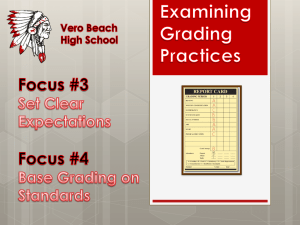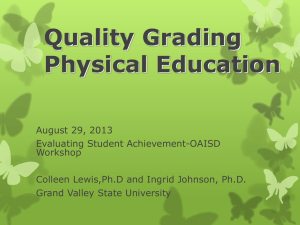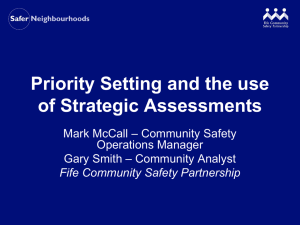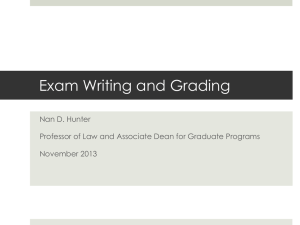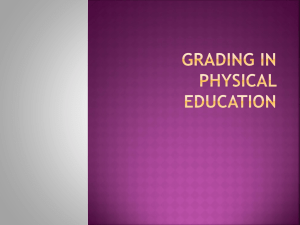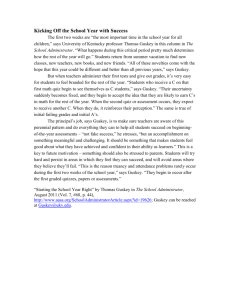Assessment Literacy
advertisement
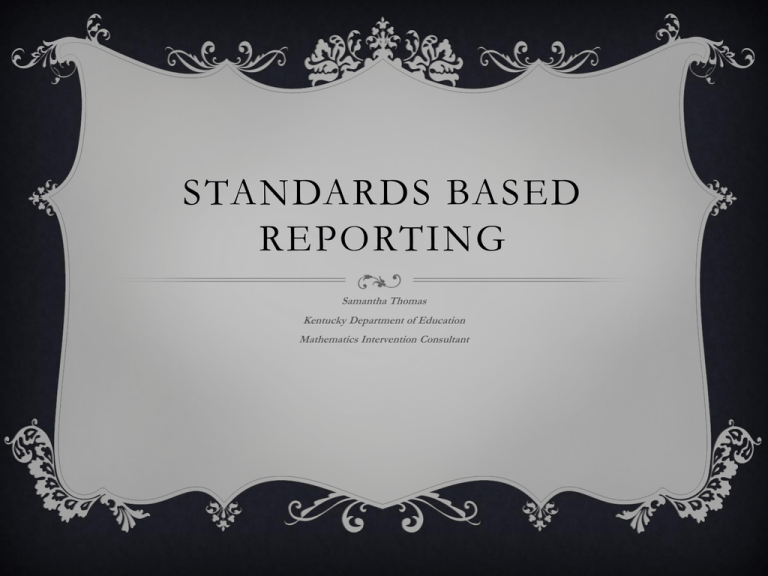
STANDARDS BASED REPORTING Samantha Thomas Kentucky Department of Education Mathematics Intervention Consultant OVERVIEW Definition and Purpose W H A T I S S TA N D A R D S B A S E D REPORTING AND WHAT IS ITS PURPOSE? Standards-Based Reporting is a refined way of reporting what students know and how they demonstrate their learning of state standards. The purpose of Standards-Based Reporting is to align grading with the state content standards measured by consistent and accurate student achievement. SNAPSHOT Before Standards Based Reporting S N A P S H O T B E F O R E S TA N D A R D S BASED GRADING….. Daily learning targets were posted on the board • (I can…. Content standard.) Assessments were driven by the daily learning targets for the unit of study Summative Assessments were administered, graded, recorded and corrected in class. Students placed the assessment in their binder to reflect (on their own) and I continued with the content GRADES IN MY CLASSROOM BEFORE S TA N D A R D S B A S E D G R A D I N G … . Daily homework grades were given based on effort and completion. (10 points) Quizzes and Tests were Some students attain an “A” average on homework although eighty percent of their work may be incorrect. Assessments were graded, administered throughout the recorded, corrected and given to units to monitor learning and the students. No further analysis achievement. of the assessment was completed. GRADES IN MY CLASSROOM BEFORE S TA N D A R D S B A S E D G R A D I N G … . . Students were given a binder Students were receiving grade worth 100 points. Fifty achievement marks based on points for the organization, their ability to organize notes, etc. and fifty points for information and be responsible. their content vocabulary Students received notebook. achievement marks for listening Weekly Participation Points and contributing to the conversation. REALIZING THE PROBLEM Should grades be indicative of student performance? HUGE GAPS Identified issues in my classroom • • Why did most of my students have A’s and B’s if their assessment results were below average percentiles? Why weren’t they learning from their mistakes that I marked on their tests? RESTRUCTURING OUR THINKING How do we ensure that achievement marks are a true measure of STUDENT ACHIEVEMENT? TIME FOR CHANGE The marks my students received at the end of each semester were not indicative of their performance. Students were not learning from their mistakes because they did not have the tools or the information needed to assess their comprehension of the learning targets. Standards Based reporting was Implemented CONSIDER What should student grades represent? Should students be able to self analyze their own learning? Is homework an achievement mark or a support to master content? What tools do students need in order to self analyze? Should students have only one opportunity to show comprehension? ASSESSMENT PROCESS Learning to self analyze ALL WORK BEGINS POST ASSESSMENT After Summative assessment were administered and scored, feedback is provided to students and each student completes an assessment analysis tool. This allows them to identify which targets they mastered and other targets that require further growth. ASSESSMENT ANALY SIS After each assessment (instead of throwing them away) students analyze their assessment to find their mathematical mistakes. Students become aware of their misconceptions and begin appropriate practice to master the targets. • Students have support for this process through small groups, teacher-student conferences, and one on one instruction as needed. ASSESSMENT ANALY SIS ASSESSMENT ANALY SIS LIFE LONG LEARNERS The Re-Assessment Procedure ASSESSMENT PROCESS Students complete the unit assessment. After receiving the results students complete the assessment analysis to locate the standards they did not master. Students only complete a re-assessment for those targets they did not master. Students wanting to reassess must conference with teacher first and bring the following to show proof of work. • The assessment analysis tool • All completed homework (suggested practice) • Completed study guide WHAT HOMEWORK? Homework does not disappear when implementing Standards Based Reporting. Homework is still required but is viewed as a support to reach mastery for the learning targets. Homework is a requirement in order to have the right to re-assess of targets. Homework grades may still be recorded in Infinite Campus for tracking purposes with zero weight assigned. ASSESSMENTS Round 1 Assessment is composed of multiple choice questions, short answer, and extended response. Students are required to show work. If students do not master the assessment, they must conference with me and bring the required work. (Assessment analysis, Study Guide, Completed Homework) ASSESSMENTS Round 2 Assessment consist of short answer questions and extended response. The questions are completely new. This is not a system in which the same assessment is administered over and over until mastery is reached. If students do not master the second assessment, they must again conference with me and bring the required work. (First and Second Assessment analysis, Second Study Guide) ASSESSMENTS Round 3 Assessments require more work. Students must complete extended response questions, show their work AND provide a rationale for how they arrived at each step. If the third assessment is not mastered further steps are taken within systems of intervention to address misconceptions. • RtI, ESS, etc. ASSESSMENTS All assessments are laid out with an “I Can” statement for each section. Using “I Can” statements allows students to become familiar with the content. If large summative assessments were administered, the “I Can” statements were removed. ACHIEVEMENT MARKS How are students graded? STUDENT ACHIEVEMENT MARKS WITH S TA N D A R D S B A S E D G R A D I N G …. Students are graded strictly on the achievement level of their assessments. Assessments are not limited only to paper and pencil, the teacher can also use: • Product Based Assessment(composing a three dimensional model labeling the components and calculating the volume of the solid.) • Performance Based Assessment (Speaking to classmates and presenting the process of photosynthesis) GRADES Students are graded on a ranking system of 1 to3. • 3 (Mastery) This means that a student is able to demonstrate clear and consistent understanding of the knowledge, reasoning, skill and product target. • 2 (Developing) This means that a student demonstrates understanding, but does so on an inconsistent or incomplete manner. • 1 (Beginning or Below Basic) This means that a student demonstrates limited understanding of the target. • Other standards based grading examples consist of skill levels 1, 2, 3, and 4. This ranking system is up to the district. GRADE BOOK COMPARIS ON DATA TRACKING How is student growth tracked? DATA TRACKING Using a color coded excel spreadsheet enabled me to analyze achievement improvement throughout the semester. Row averages showed individual student achievement while vertical averages showed target achievement. Composing a graph of target based performance quickly showed the vast improvements students were making. DATA TRACKING DATA TRACKING DATA TRACKING DATA TRACKING YEAR END RESULTS What did the year end data say? THE RESULTS Eighth grade students showed 17.5% increase in proficient and distinguished students when compared to 2010 eighth grade performance. KCCT RESULTS WHY CHOOSE STANDARDS BASED GRADING? Accountability is on the student and they become involved in their education and take ownership of learning Differentiates learning Progress monitoring of each student Allows students to see where their areas of growth are needed Analysis of student achievement and target performance Less time spent grading, more time spent creating effective classroom assessments and instructional plans ROLES AND RESPONSIBILITIES Support from all Parties ADMINISTRATIVE SUPPORT Parent support throughout this process is vital. • Concerns • • • Most parents will not like homework not counting as a grade. Understanding the process of re-assessment and grading is important. Understanding of differentiation is important Parent Communication • Letters Home • One Call System • Teachers can address regular parent teachers communications via phone, email, and conferences • Understanding the Grade Book in Infinite Campus ADMINISTRATIVE SUPPORT Learning the Process • Conferences that model standards based grading • Online Resources • Books and articles Positive Attitude • Towards Parents • Towards Students Ongoing Collaborative Discussions • • • • Parent Concerns Program Troubleshooting Progress Monitoring Reflection TEACHER RESPONSIBILITIES Providing students with appropriate supports for success • • • • • Time for mini-lessons and re-assessments whether during class, before or after school Continuous Progress Monitoring Assessment Building (self constructed, or use of classroom and online resources) Transforming students view of homework from an effort grade to practice (Feedback from homework should be formative) Flexibility in instruction and grading TEACHER RESPONSIBILITIES Administrative Collaboration • Ongoing updates to building administrators for progress monitoring and front loading Parent Communication • Ongoing communication for updating student achievement Attitude (Important) • Positive attitude towards standard based grading for student buy in • Positive attitude towards standard based grading for parent buy in FRONTLOADING Standards based reporting takes time to implement. This is not a system that can be quickly created. Suggestions: • Pilot the program to address issues and reflect upon the process before implementing school wide. • Find resources available for Standards Based Reporting and build from there based on what works best in your classroom. REFLECT Are today’s classrooms structured in a manner that: • Address individual learning needs • • • • Which means Not teaching 30 students in a classroom the same content because five students still near to hear the repeated lesson just LONGER and LOUDER Enable students to self analyze Encourage students to become stakeholders in their education Allow time for mastery and learning instead of our timeline If not WHY? RESOURCES Informational sites and Articles RESOURCES http://pdonline.ascd.org/pd_online/teachbe have2/el200302_guskey.html http://www.nesacenter.org/uploaded/confer ences/FLC/2010/spkr_handouts/Guskey_Grad ing_Binder.pdf RESOURCES http://tccl.rit.albany.edu/knilt/images/4/40 /Standards_based_grading.pdf http://www.naesp.org/resources/2/Leaders hip_Compass/2006/LC2006v4n2a3.pdf QUESTIONS If you would like samples of any of the resources I have used in my classroom such as Target Based Assessments, Assessment Analysis tools, spreadsheets for grading, or have any further questions please mail me at samantha.thomas@education.ky.gov REFLECT What did you learn today about standards based reporting? Is there anything that is still unclear to you and should have been addressed in more detail throughout the presentation?

